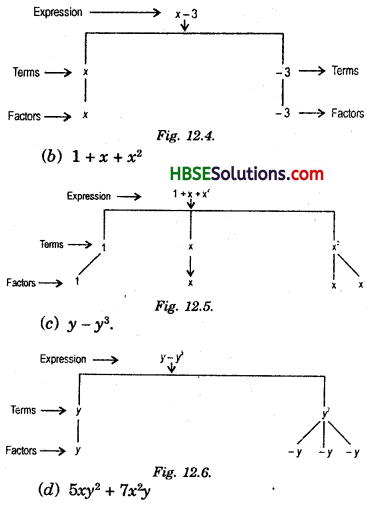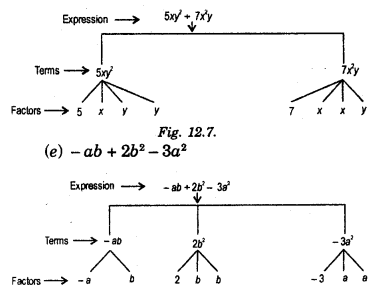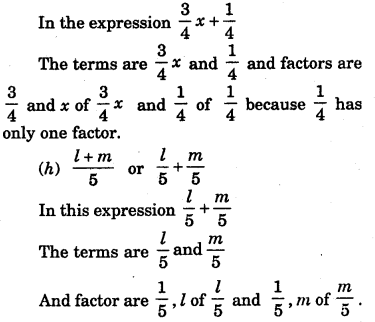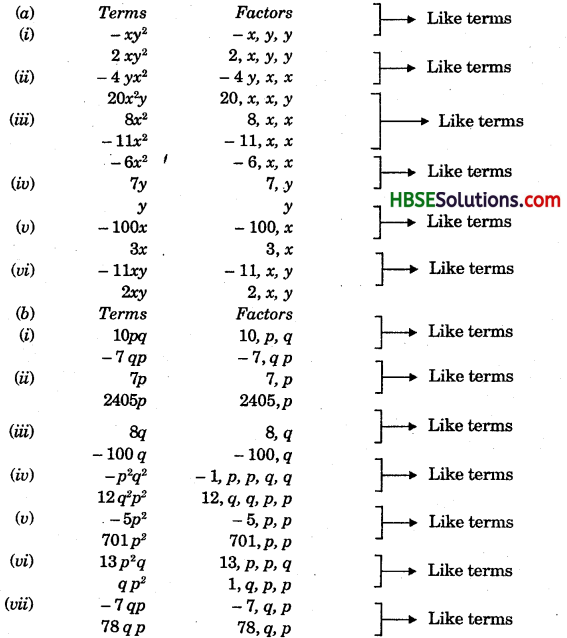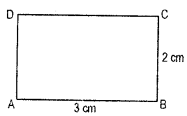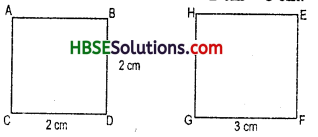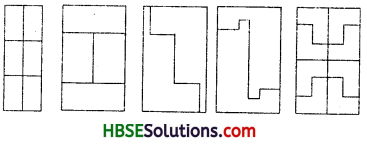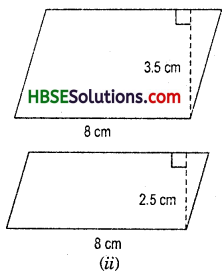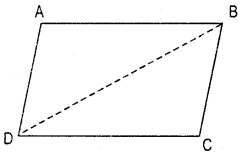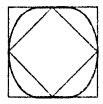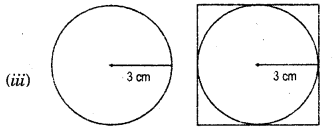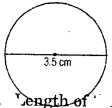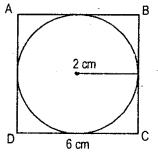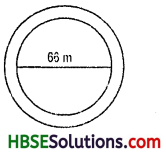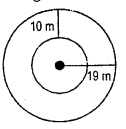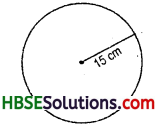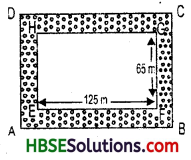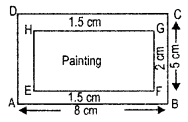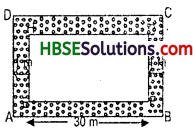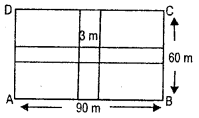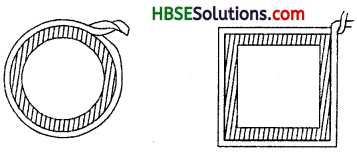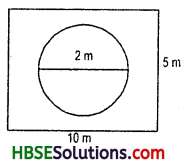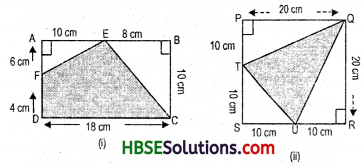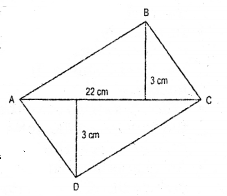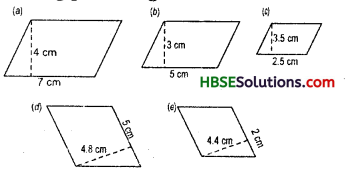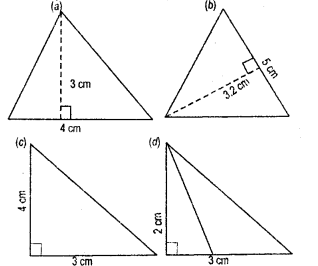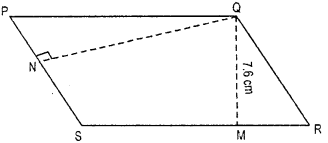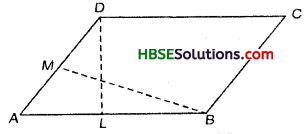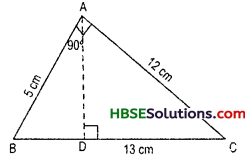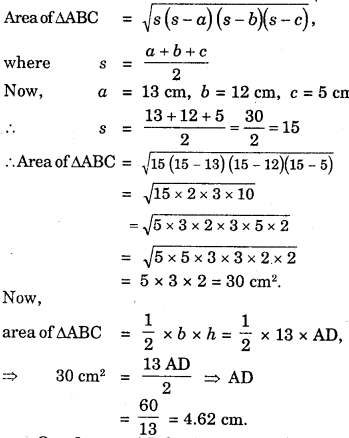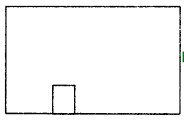HBSE 7th Class Maths Solutions Chapter 12 Algebraic Expressions Ex 12.3
Haryana State Board HBSE 7th Class Maths Solutions Chapter 12 Algebraic Expressions Ex 12.3 Textbook Exercise Questions and Answers.
Haryana Board 7th Class Maths Solutions Chapter 12 Algebraic Expressions Exercise 12.3
Question 1.
If m = 2, find the value of:
(i) m – 2
(ii) 3m – 5
(iii) 9 – 5m
(iv) 3m2 – 2m – 7
(v) \(\frac{5 m}{2}\) – 4
Solution:
(i) m – 2 – 2 – 2 = 0
(ii) 3m – 5 = 3(2) – 5 = 6 – 5 = 1
(iii) 9 – 5 m = 9 – 5(2) = 9 – 10 = – 1.
(iv) 3m2 – 2m – 7
= 3(2)2 – 2(2) – 7
= 3 × 4 – 4 – 7
= 12 – 4 – 7 = 8 – 7 = 1
(v) \(\frac{5 m}{2}\) – 4 = \(\frac{5 \times 2}{2}\) – 4
= \(\frac{10}{2}\) – 4 = 5 – 4 = 1
Question 2.
If P = – 2, find the value of;
(i) 4p + 7
(ii) – 3p2 + 4p + 7
(iii) – 2p2 – 3p2 + 4p + 7, when p = – 2.
Solution:
(i) 4p + 7 = 4(- 2) + 7 = – 8 + 7
= -1
(ii) – 3(-p)2 + 4(-p) + 7
= – 3(- 2)2 + 4(- 2) + 7
= – 3 × 4 + 4 × -2 + 7
= – 12 – 8 + 7
= – 13.
![]()
(iii)- 2p2 – 3p2 + 4p + 7
= -2(-2)2 – 3(- 2)2 + 4 × (- 2) + 7
= -2 × 4 – 3 × 4 + 4 × – 2 + 7
= -8 – 12 – 8 + 7
= -21.
Question 3.
Find the value of the following expressions, when x = – 1.
(i) 2x- 7
(ii) -x + 2
(iii) x2 + 2x + 1
(iv) 2x2 – x – 2.
Solution:
(i) 2x – 7 = 2(-1) – 7 = -2 – 7
= -9
(ii) -x + 2 = – (-1) + 2
= 1 + 2 = 3
(iii) x2 + 2x + 1
= (- 1)2 + 2(- 1) + 1
= 1 – 2 + 1 = 0.
(iv) 2x2 – x – 2 = 2(- 1)2 – (- 1) – 2
= 2 × 1 + 1 – 2
= 2 + 1 – 2
= 3 – 2 = 1.
Question 4.
If a = 2, b = – 2, find the value of:
(i) a2 + b2
(ii) a2 + ab + b2
(iii) a2 – b22.
Solution:
(i) a2 + b2 = (2)2 + (- 2)2
= 4 + 4
= 8
![]()
(ii) a2 + ab + b2 = (2)2 + 2 x -2 + (-2)2
= 4 – 4 + 4
= 8 – 4 = 4.
(iii) a2 – b2 = (2)2 – (- 2)2
= 4 – 4
= 0.
Question 5.
When a = 0, b = -1, find the value of the given expressions:
(i) 2a+2b
(ii) 2a2 + b2 + 1
(Hi) 2a2b + 2ab2 + ab
(iv) a2 + ab + 2.
Solution:
(i) 2a + 2b = 2 × 0 + 2(- 1)
= 0 + (- 2) = – 2
(ii) 2a2 + b2 + 1 = 2(0)2 + (- 1)2 + 1
= 2 × 0 + 1 + 1
= 1 + 1 = 2.
(iii) 2a2b + 2ab2 + ab
= 2(0)2 (- 1) + 2 × 0(- 1)2 + 0 × – 1
= 2 × 0 × (-1) + 2 × 0 × 1 + 0
= 0 + 0 + 0 = 0
(iv) a2 + ab + 2
a = 0
b = -1
= (0)2 + (0) (- 1) + 2
= 0 + 0 + 2 = 2.
![]()
Question 6.
Simplify the expressions and find the value of x is 2.
(i) x + 7 + 4(x – 5)
(ii) 3(x + 2) + 5x – 7
(iii) 6x + 5(x-2)
(iv) 4(2x – 1) + 3x + 11
Solution:
(i) x + 7 + 4(x – 5)
= x + 7 + 4x – 20
= 2 + 7 + 4 × 2 – 20
= 9 + 8 – 20
= 17 – 20 = – 3.
(ii) 3(x + 2) + 5x – 7
= 3x + 6 + 5x – 7
= 3 × 2 + 6 + 5 × 2 – 7
= 6 + 6 + 10 – 7
= 12 + 10 – 7
= 22 – 7 = 15.
(iii) 6x + 5(x – 2) = 6x + 5x – 10
= 6 × 2 + 5 × 2 – 10
= 12 + 10 – 10
= 22 – 10 = 12.
(iv) 4(2x – 1) + 3x + 11
= 8x – 4 + 3x + 11
= 8 x 2 – 4 + 3 x 2 + 11
= 16 – 4 + 6 + 11
= 12 + 6 + 11
= 18 + 11
= 29.
![]()
Question 7.
Simplify these expressions and find their yalue of x = 3, a = – 1, b = – 2,
(i) 3x – 5 -x + 9
(ii) 2 – 8x + 4x + 4
(iii) 3a + 5 – 8a + 1
(iv) 10 – 3b – 4 – 5b
(v) 2a – 2b – 4 – 5 + a.
Solution:
(i)3x – 5 – x + 9
= 3 × 3 – 5 – 3 + 9
= 9 – 5 – 3 + 9
= 4 – 3 + 9
= 1 + 9 = 10.
(ii) 2 – 8x + 4x + 4
= 2 – 8 × 3 + 4 × 3 + 4
= 2 – 24 + 12 + 4
= 18 – 24 = – 6.
(iii) 3a + 5 – 8a + 1
= 3(- 1) + 5 – 8(- 1) + 1
= -3 + 5 + 8 + 1
= 2 + 8 + 1 = 11.
(iv) 10 – 3b – 4 – 5b
= 10 – 3(-2) – 4 – 5(-2)
= 10 + 6 – 4 + 10
= 16 – 4 + 10 = 12 + 10
= 22.
![]()
(v) 2a -26-4-5 + a
= 2(-1) – 2(-2) – 4 – 5 + (-1)
= -2 + 4 – 4 – 5 – 1
= 2 – 9 – 1
= 2 – 10 = -8.
Question 8.
(a) If z = 10, find the value of z3 – 3(z -10).
(6) If p = -10 find the value of p2 – 2p – 100.
Solution:
(a) z3 – 3(z -10)
= (10)3 – 3(10-10)
= 1000 – 3 x 0
= 1000 – 0 = 1000
(b) p2 – 2p – 100 = (- 10)2 – 2 x (- 10) – 100
= 100 + 20 – 100
= 120 – 100 = 20.
Question 9.
What should be the value of a if the value of 2x2 + x – a equals to 5, when x = 0 ?
Solution:
2x2 + x – a = 5
2(0)2 + 0 – a = 5
or 2 x 0 + 0 – a = 5
or -a = 5 or a = -5
![]()
Question 10.
Simplify the expression and find its value when a = 5 and b = – 3, 2(a2 + ab) + 3 – ab.
Solution:
2(a2 + ab) + 3 – ab
= 2a2 + 2ab + 3 – ab
= 2a2 + ab + 3
= 2 × (5)2 + (5) × (-3) + 3
= 2 × 25 + (- 15) + 3
= 50 – 15 + 3
= 53 – 15 = 38.
HBSE 7th Class Maths Solutions Chapter 12 Algebraic Expressions Ex 12.3 Read More »
